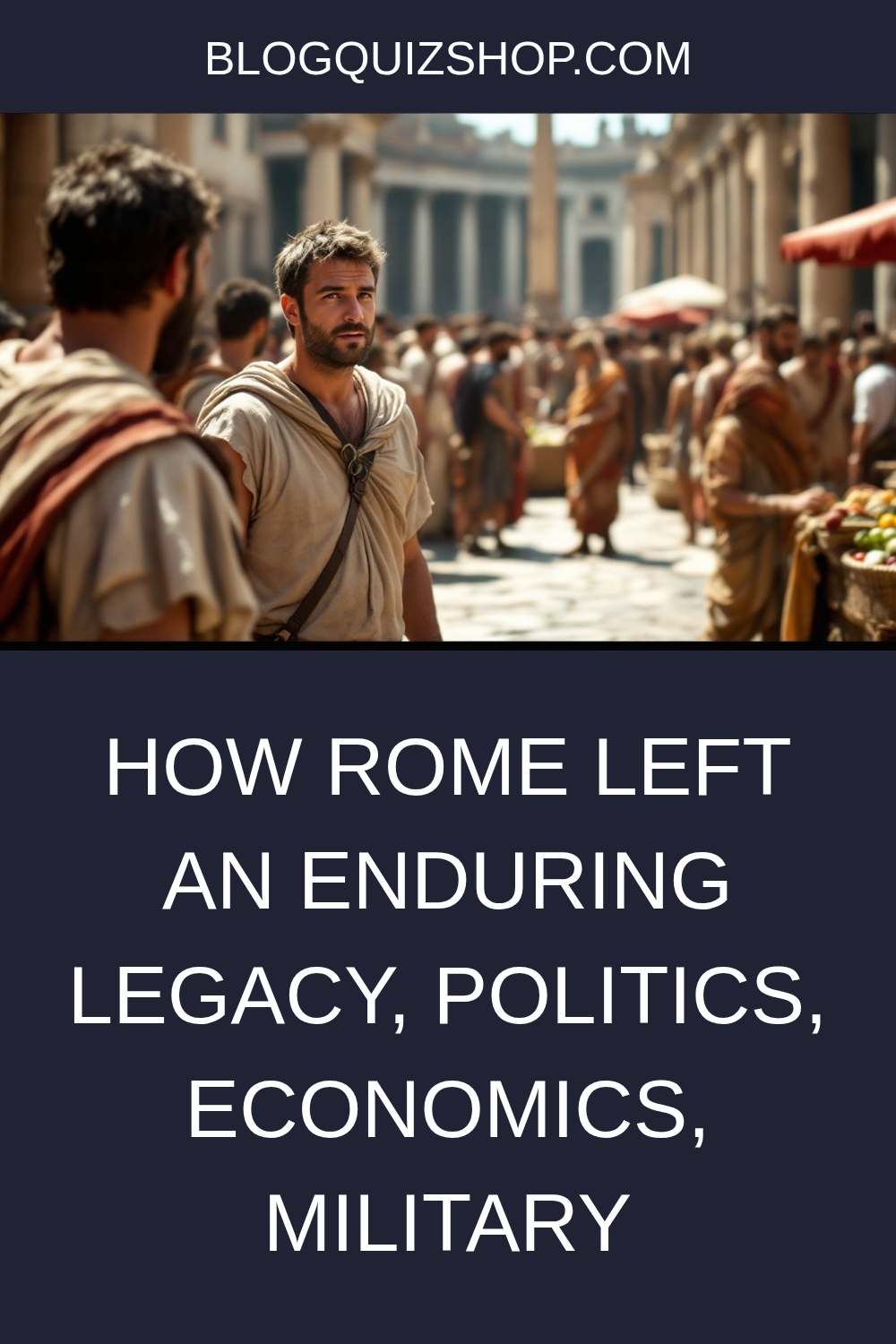Ever pondered about the continued prominence of the Roman Empire today?What Rome left, its influence is pervasive – from the structure of our governments to our spoken languages. The empire’s actions have had a lasting effect, shaping parts of the world significantly and enduringly.
A crucial detail: Rome established more than 500 cities and brought forth advancements in law, government, military tactics, and economics which constitute the foundation of today’s society.
This article analyzes what Rome left political, economic, and military accomplishments and their enduring effects on history. Prepare to discover how ancient decisions impact our current lives.
Continue reading for a captivating voyage through time!
Key Takeaways
- Rome introduced ideas in government that shape modern democracies, like voting and the Senate. This affected how countries make laws.
- Trade network and money system from Rome still influence today’s global economy. Romans used coins and had vast trade links that connect to our use of money and trade.
- Roman military strategies, such as discipline and organization into units, guide modern armies. Their innovations changed warfare.
- The legal system Rome created, including written laws like the Twelve Tables, set a base for current legal systems around the world.
- Language and culture spread by Rome affect many aspects of life today, including languages derived from Latin and city planning based on Roman models.
SHOP NOW ZAZZLE - CLICK BELOW
Rome Left many Legacies some are around Today
Rome left an enduring legacy in politics, economics, and military tactics is foundational to Western civilization and continues to influence the modern world.
Political Legacy
Republican Government and Checks and Balances
The Roman Republic introduced a system where power was distributed among various institutions—Senate, consuls, and popular assemblies—with checks and balances to prevent any one individual from dominating the state. This model inspired the structure of modern democratic governments, notably the United States, where the executive, legislative, and judicial branches echo Roman precedents.
Rule of Law
Roman law, codified in texts like the Twelve Tables, established principles such as equality before the law, rights of citizens, and legal procedures (trials with judges, plaintiffs, and defendants) that underpin many contemporary legal systems.
Political Participation and Social Mobility
While initially dominated by patricians, the Roman system gradually expanded rights and representation to plebeians, setting a precedent for broader civic participation. The cursus honorum (sequence of public offices) allowed for merit-based advancement, a concept mirrored in modern civil services.
Influence on Political Thought
Roman thinkers like Cicero deeply influenced Enlightenment philosophers and the framers of modern constitutions, embedding Roman ideals in Western political culture.
The Economic Legacy that Rome left
Property Rights and Legal Frameworks
Roman property laws laid the groundwork for modern concepts of private property, inheritance, and contracts, which are central to today’s legal and economic systems.
Trade Networks and Infrastructure
Rome’s extensive road and maritime networks facilitated trade across the Mediterranean and beyond, connecting distant provinces and promoting economic integration. These infrastructural achievements became models for later empires and modern states.
Currency and Markets
The introduction of standardized coinage (denarius) enabled efficient commerce and tax collection, supporting a market economy that, according to some historians, rivaled the prosperity of early modern Europe.
Taxation and Public Works
Rome’s sophisticated tax system funded vast public projects—roads, aqueducts, public buildings—demonstrating the economic power of centralized state planning and public investment.
Agriculture and Slavery
The Roman economy was fundamentally agrarian, with large estates (latifundia) and reliance on slave labor. While this created economic inequalities and ultimately contributed to Rome’s decline, the scale and organization of Roman agriculture influenced later European economic structures.
Lessons for Modern Economics
Rome’s experiences with inflation, currency debasement, and overreliance on slave labor offer enduring lessons about economic stability and the risks of systemic imbalances.
Military Tactics Legacy
Organizational Flexibility
Roman legions were renowned for their adaptability and discipline. The manipular and later cohort systems allowed for flexible deployments, enabling Roman armies to fight effectively on varied terrain against diverse enemies.
Three-Line Formation and Reserves
The classic Roman “triplex acies” (three-line formation: hastati, principes, triarii) allowed fresh troops to relieve the front lines, maintaining combat effectiveness and psychological resilience during prolonged battles.
Combined Arms and Engineering
Romans integrated infantry, limited cavalry, and missile troops (velites), and were pioneers in military engineering—building forts, roads, and siege works that supported sustained campaigns.
Adaptation and Innovation
Rome’s ability to learn from defeats (notably against Hannibal in the Second Punic War) led to tactical innovations such as Fabian delaying tactics and the use of pincer movements and integrated strategies, blending military, diplomatic, and economic tools.
Professionalization and Logistics
The Roman military evolved into a professional standing army with standardized training, equipment, and supply lines, influencing the development of later European armies
Rome Left Enduring Legacies
| Domain | Key Legacy Elements | Modern Impact |
|---|---|---|
| Politics | Republican government, checks and balances, legal equality, civic participation | Structures of Western democracies, legal systems, civil rights |
| Economics | Property laws, trade networks, standardized currency, taxation, public works, market economy | Modern property rights, infrastructure, economic policy |
| Military | Flexible formations, reserves, combined arms, adaptation, professionalization, logistics | Modern military organization, tactics, and engineering |
Rome’s legacies in these domains are not only historical curiosities—they are living traditions, embedded in the political institutions, economic systems, and military doctrines of the modern world
Political Structures and Governance

Rome left a political structure that shapes how we rule nations today, for example the United States. It started with the Roman Republic, where people had a say in decisions, and moved to an empire ruled by one person. This change showed us two ways to govern – through shared power or under one leader.
Now, countries use bits of both systems to make laws and lead their people.
Roman political institutions limited both the power of individuals and the influence of the poor through a complex system of checks, balances, and social hierarchies.
Limiting Individual Power
Dual Consulship and Short Terms
The highest executive office, the consulship, was always held by two individuals at the same time, each with the power to veto the other’s decisions. Consuls served only one-year terms, preventing any one person from amassing excessive power or establishing a personal dictatorship.
Checks and Balances
Power was distributed among various magistrates, the Senate, and popular assemblies. No single office or individual could govern unilaterally under normal circumstances.
Oversight and Accountability
Consuls and other magistrates were subject to oversight by the Senate and could not act without popular approval for major decisions. Religious officials also had the authority to interfere in political matters, further diluting personal power.
Dictatorship as an Exception
In emergencies, a dictator could be appointed with near-absolute power, but this office was strictly limited to a six-month term and was rarely abused until the late Republic.
Limiting the Power of the Poor
Wealth-Based Voting Systems
The main voting assemblies, especially the Centuriate Assembly, were organized by wealth. The wealthiest classes were divided into more, smaller voting groups, giving each wealthy citizen’s vote greater weight than those of the poor. The poorest citizens, the proletarii, were grouped into a single voting unit, drastically reducing their influence.
Restricted Access to Office
Political offices were initially reserved for patricians (the aristocracy), and even after reforms, the upper classes continued to dominate these positions due to their resources, networks, and patronage systems.
Social Barriers and Disenfranchisement
Many poor Romans were effectively disenfranchised, either because they were not citizens or because they could not afford the time and cost to participate in elections held in Rome.
Legal Inequality
The legal system imposed harsher punishments on the poor, such as corporal punishment or forced labor in mines, while wealthier individuals could pay fines for similar offenses.
Efforts to Expand Popular Power
Plebeian Council and Tribunes: Over time, plebeians (commoners) gained some political power through the creation of the Plebeian Council and the office of tribune, which could veto actions by other magistrates and propose laws. However, even these institutions were often subject to manipulation or co-optation by the elite.
Conflict of the Orders
The centuries-long struggle between patricians and plebeians (the Conflict of the Orders) led to incremental reforms, such as the right for plebeians to hold office and for their assembly’s decisions to bind all Romans. Yet, the wealthy continued to dominate the political system through control of key institutions and voting structures
How Roman Institutions Limited Power
| Who Was Limited | Mechanism of Limitation | Effect |
|---|---|---|
| Individuals | Dual consulship, term limits, vetoes, checks and balances | Prevented concentration of power in one person |
| The Poor (Plebeians) | Wealth-based voting, restricted office access, legal inequality | Maintained elite dominance, limited poor’s political sway |
Roman political institutions were designed to prevent the rise of tyrants but also to preserve the dominance of the elite. Systematically limiting the influence of both individuals and the lower classes, this is what Rome left.
Roman institutions prevented wealthy elites from consolidating unchecked power
Roman institutions prevented wealthy elites from consolidating unchecked power through a system of overlapping offices, legal checks, and structured competition, though these measures were not always fully effective in practice.
Key Mechanisms Limiting Elite Power:
Dual Magistracies and Short Terms
The most powerful executive positions, such as the consuls, were always held by two individuals at the same time, each able to veto the other’s decisions. Terms were limited to one year, making it difficult for any one person or family to dominate government for long periods.
Checks and Balances
Power was distributed among several magistrates (consuls, praetors, censors, tribunes), the Senate, and popular assemblies. No single office could act without the cooperation or approval of others. For example, consuls required Senate approval for major decisions, and their actions could be vetoed by their colleague or by tribunes.
Popular Assemblies and Tribunes
While the Senate was dominated by elites, the creation of the Plebeian Council and the office of Tribune of the Plebs provided institutional checks. Tribunes could veto actions by magistrates and the Senate, and the Plebeian Council could pass binding laws for all Romans, at least in theory.
Special Courts and Oversight
Special courts were established to investigate abuses such as extortion by governors, providing a legal mechanism to hold elites accountable for misconduct.
Temporary Dictatorship
In emergencies, a dictator could be appointed with near-absolute power, but this office was strictly limited to six months. This prevented long-term autocracy and ensured that extraordinary powers were only a temporary measure.
Cursus Honorum
The structured sequence of offices (cursus honorum) required aspiring politicians to serve in lower offices before reaching higher ones, promoting competition and preventing any single individual from monopolizing power for life.
Limitations and Realities
Elite Influence Remained Strong
Despite these safeguards, wealthy families often controlled voting blocs, influenced the Senate, and manipulated assemblies to their advantage. The system was designed to balance power, but in practice, the elite maintained significant informal control over political processes.
Consensus and Competition
The Roman constitution fostered consensus-building and competition among elites, channeling ambition into public service rather than tyranny. However, as the Republic aged, ambitious individuals increasingly found ways to circumvent these limits, contributing to its eventual collapse
Development of the Republic and Imperial Systems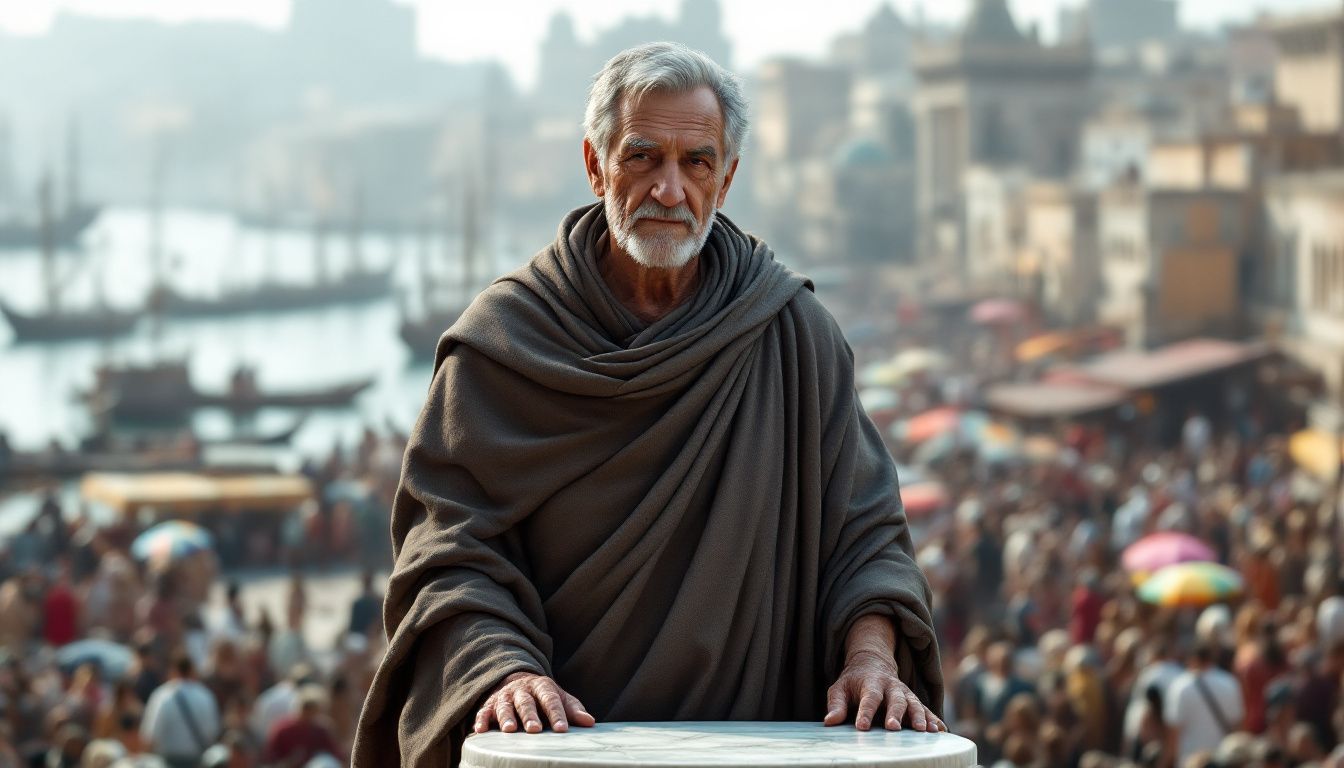
The change from the Roman Republic to the Imperial system reshaped how Rome ruled. Under the Republic, leaders like consuls shared power and citizens had a say through voting. This way of governing lasted until Julius Caesar came along, showing that one ruler could hold much power.
After his death, Augustus took over and started what we call the Empire. He became the first Roman Emperor, changing leadership for good.
“Power grows out of a barrel of a sword,” might sum up how Rome shifted from many sharing power to one person ruling all. The Eastern and Western Roman Empires later showed this change clearly.
While East continued under leaders like Theodosius I, West fell apart due to attacks by Germanic tribes and internal troubles.
This move from republic to empire didn’t just change who was in charge; it changed how Rome interacted with the world. Trading grew under emperors’ protection, cities expanded as colonies spread throughout Europe and beyond.
This growth helped ideas, language – even laws spread far and wide.
Influence on Modern Democratic Forms
Rome’s political ideas have shaped today’s democracies. The Roman Republic had senators and other officials elected by citizens. This idea influenced many countries to form their own democratic systems, thus Rome left a impact.
People vote for leaders just like Romans did.
Roman law also plays a big role in modern legal systems. Laws about property, rights, and justice come from Rome. Countries around the world use these ideas to make their laws fair.
The Pax Romana showed how peace helps trade and prosperity grow. Today, countries work together in groups like the European Union to support peace and trade. Rome’s example teaches us that stability leads to success.
The Economic Impact that Rome left
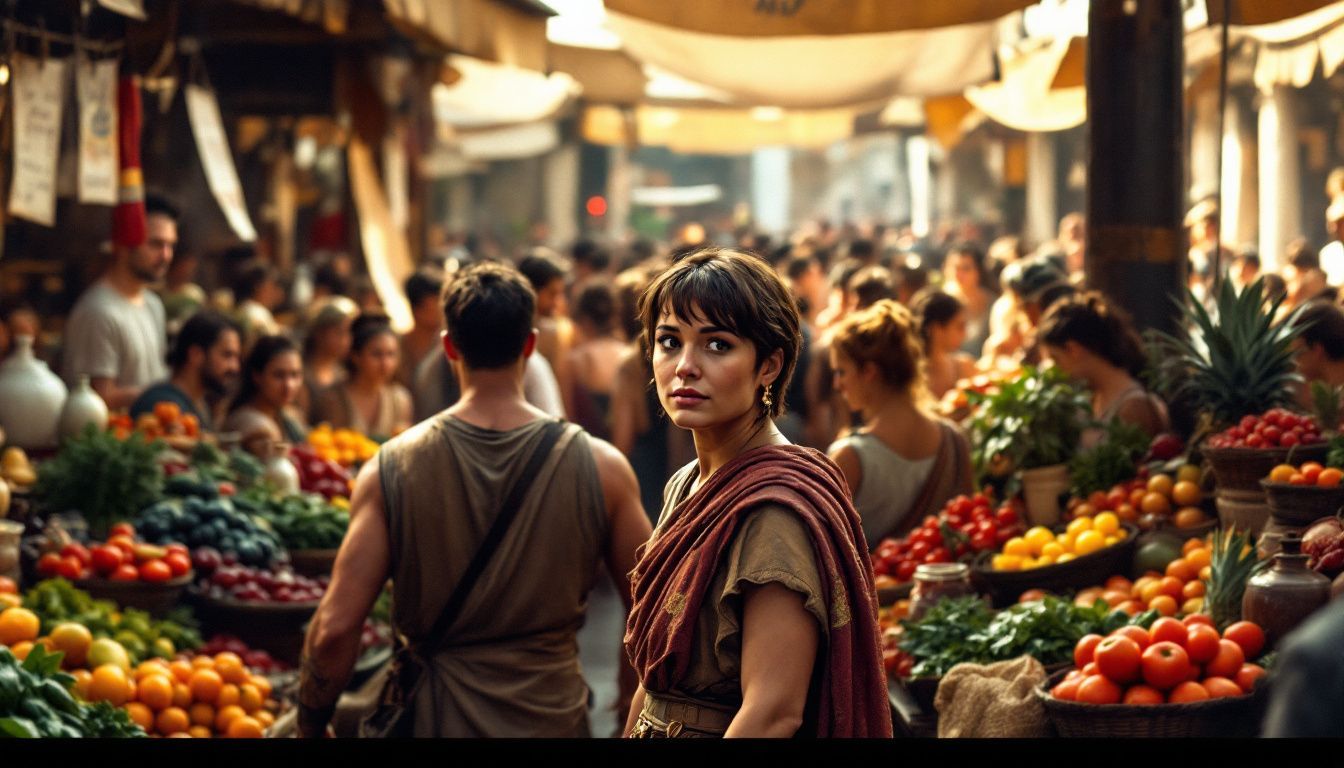
Rome’s trade networks spread far and wide, bringing wealth from all corners of the empire. Their money system set a foundation that the modern world still uses today.
Expansion and Trade Networks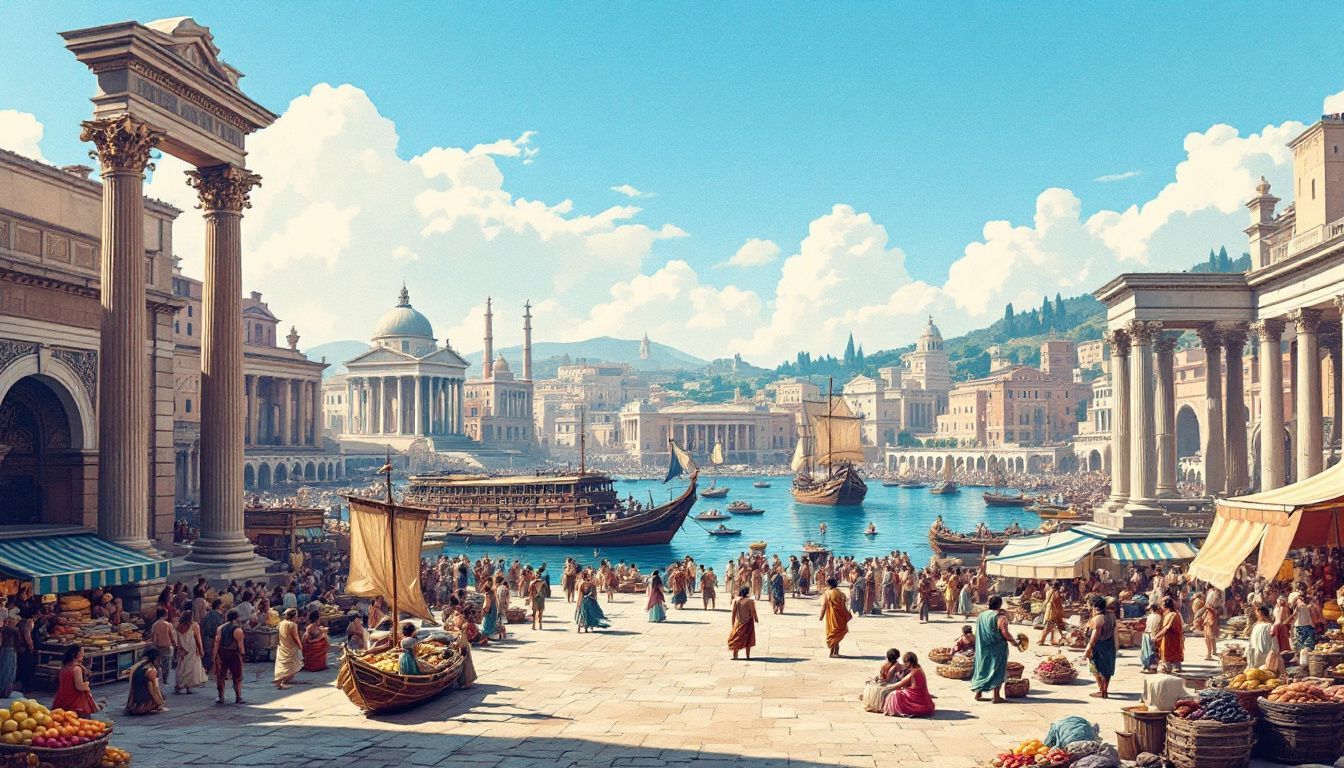
The Roman Empire grew fast, covering lands far and wide. This big area helped them set up strong trade links across the sea and on land. They built over 500 colonies, making a network that reached every corner of their empire.
These places exchanged goods like spices from Asia, silk from China, and grains from Egypt. Rome’s navy played a key role too. Under Augustus, it made sure the seas were safe for traders.
Trade brought wealth into Rome, helping the city and its people become rich. Money lending flourished during this time of peace known as Pax Romana. It let folks do business over long distances without worry.
Trade wasn’t just about getting fancy items; it also spread Roman culture and ideas to other parts of the world, including languages that came from Latin—the mother tongue in Rome. Rome left laws that many countries still use today.
Legacy of Roman Monetary Systems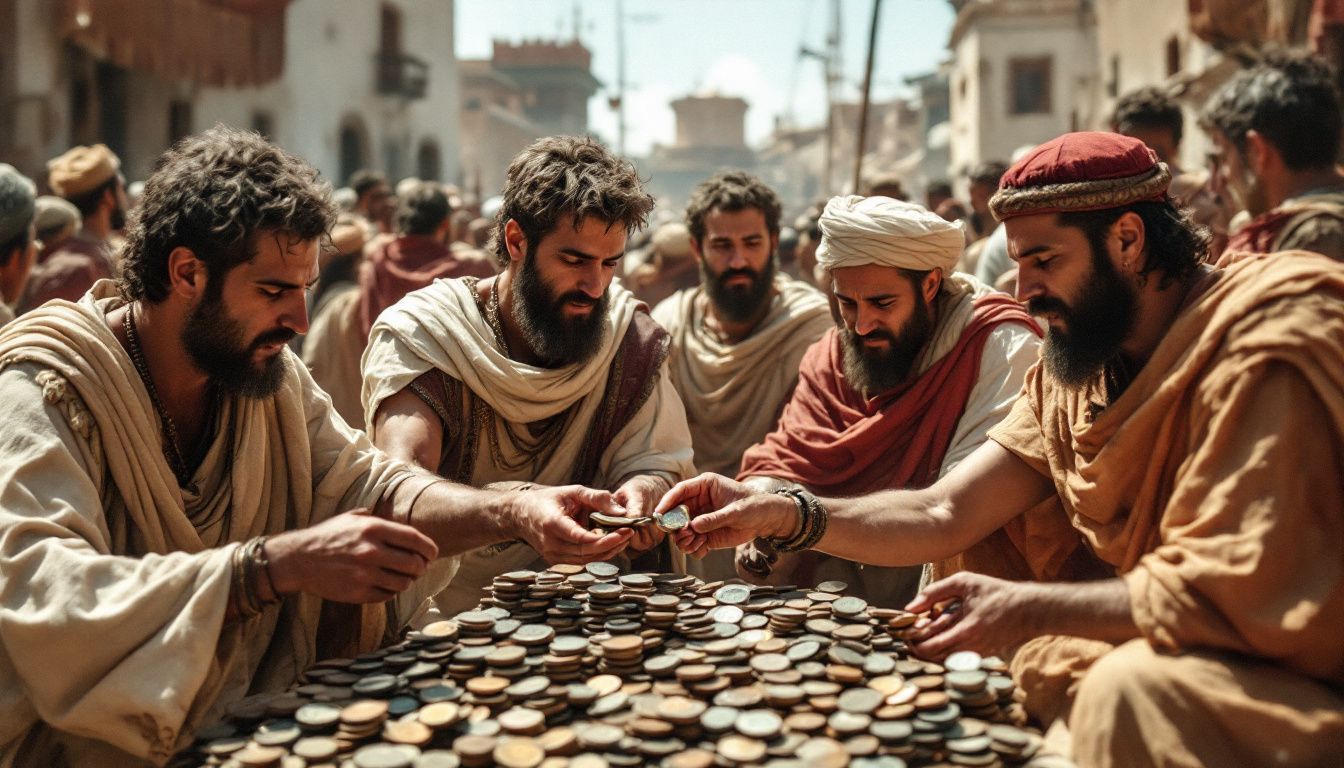
The money system that Rome left a big mark on the world. This system helped Rome grow rich from trade across the sea. Ships sailed to far places, trading goods and bringing wealth back. This made Rome a powerful player in the ancient world.
Their coins spread everywhere, showing off Roman leaders and gods.
These coins were not just money; they told stories of Rome’s greatness. They also made it easier for people to buy and sell things without bartering. This idea of coins for trade shaped how we use money today.
Roman ways of handling money laid down rules that many follow now. They showed us how banks can work, lending money and helping businesses grow. We still look back at what Rome did to learn about economy and trade.
The economic impact of the Roman Empire was profound, shaping not only its own territories but also influencing the broader Mediterranean world and beyond. The Roman economy was marked by several key features and phases, each contributing to both its periods of prosperity and its eventual decline.
Key Drivers of Roman Economic Power
Trade and Commerce
Trade was the lifeblood of the Roman economy, connecting provinces through extensive land and sea routes. The empire imported and exported a vast array of goods, including grain, olive oil, wine, metals, and luxury items such as silk and spices. These trade networks generated significant wealth and enabled Rome to sustain a large population and military.
Agriculture
The majority of Romans were engaged in agriculture, which provided food for the population and raw materials for trade. Land ownership was a primary source of wealth and social status, and agricultural surpluses supported urban centers and the army.
Slavery
Slaves were integral to the Roman economy, providing labor in agriculture, mining, construction, and domestic service. While this system enabled large-scale production and infrastructure projects, it also entrenched social inequality and contributed to economic rigidity.
Currency and Taxation
The introduction and widespread use of Roman coinage (notably the denarius) facilitated trade and tax collection. Taxes funded public works, military expenditures, and administrative costs, but over time, heavy taxation and currency devaluation contributed to economic instability.
Economic Achievements and Innovations
Infrastructure
The Romans invested heavily in roads, bridges, ports, and aqueducts, which not only facilitated military movement but also boosted commerce and communication across the empire.
Urbanization and Public Works
Wealth from trade and conquest funded the construction of cities, public buildings, and amenities, enhancing the standard of living for many citizens and showcasing Roman power.
State and Private Enterprise
The Roman economy was a mix of state control (especially in sectors like grain supply and mining) and private entrepreneurship, allowing for a diverse and dynamic economic system.
Challenges and Decline
Rising Costs
As the empire expanded, administrative and military expenses soared. When conquest slowed and fewer new resources were acquired, the state relied increasingly on taxation and currency debasement to fund its obligations, leading to inflation and fiscal crises.
Social Inequality
Wealth became concentrated among the elite, while most citizens remained poor. This disparity, combined with reliance on slave labor, hindered economic innovation and adaptability.
Inflation and Currency Devaluation
Over time, the value of Roman currency declined sharply. Inflation eroded the purchasing power of ordinary citizens, and the government’s attempts to control prices and wages led to shortages and black markets.
Economic Fragmentation
As economic pressures mounted, trade became more localized, and barter replaced currency in many regions. The breakdown of long-distance trade networks further weakened the empire’s cohesion and resilience.
The Long-Term Impact that Rome Left
The Roman Empire’s economic practices and infrastructure left a lasting legacy, influencing subsequent European economies in terms of trade, urban planning, and legal frameworks.
However, the empire’s eventual economic collapse—driven by overextension, fiscal mismanagement, and systemic inequality—serves as a historical lesson on the limits of expansion and the importance of sustainable economic policies
Now, let’s talk about ancient Rome’s military achievements and strategies…
Military Achievements and Strategies
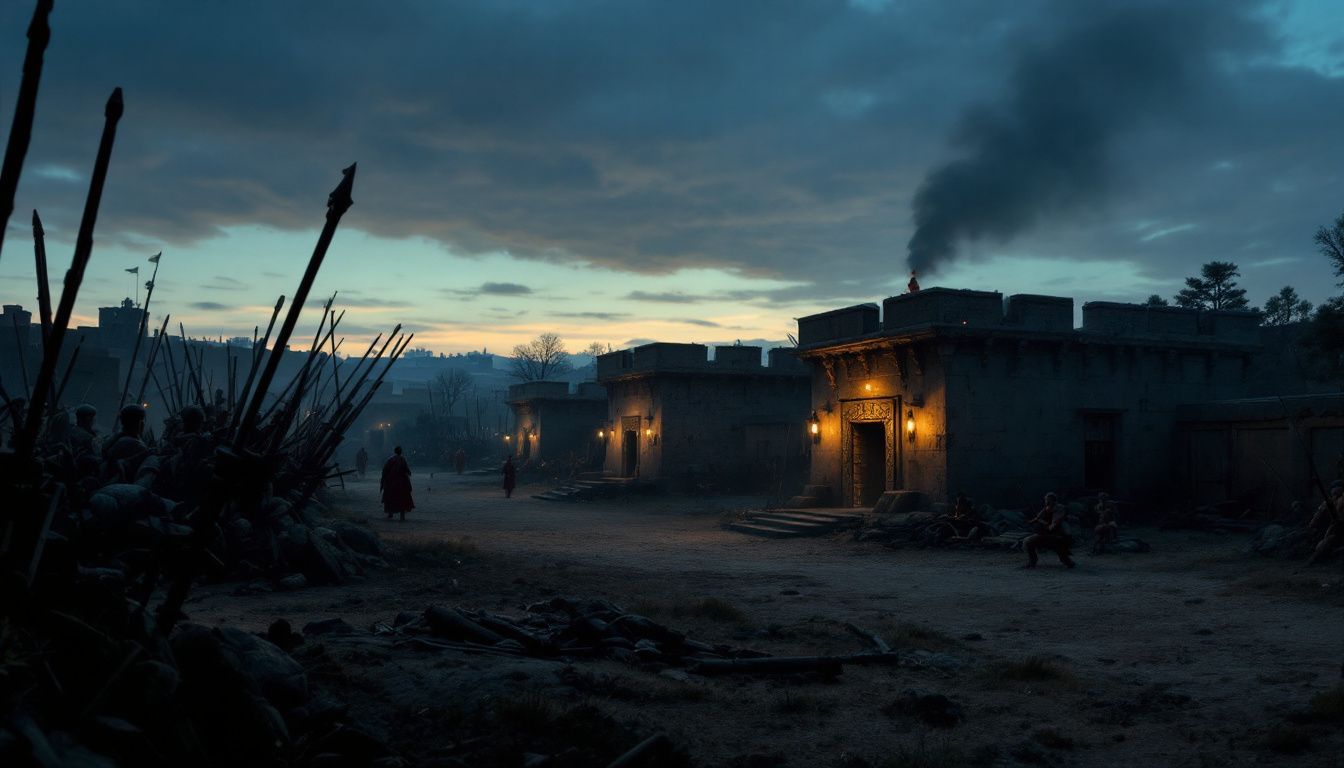
The Roman military was smart and strong. They came up with new fighting ways and technology that changed how wars were fought.
The military of the Roman Empire was a highly organized, disciplined, and innovative force that played a central role in Rome’s expansion, administration, and defense. Its structure, tactics, and equipment evolved over centuries, making it one of the most formidable military systems in history.
Organization and Structure
The backbone of the Roman military was the legion, typically comprising 4,000–6,000 soldiers, all originally Roman citizens. Each legion was divided into 10 cohorts, and each cohort into centuries of about 80 men, led by a centurion. The first cohort was often larger, with five centuries of 160 men each.
The auxiliaries (auxilia) supplemented the legions and were usually recruited from non-citizen populations across the empire. These units provided cavalry, archers, and specialized troops, often organized into cohorts of 480 men or cavalry alae of about 500 men.
The command structure included centurions (commanding centuries), tribunes (commanding cohorts), and legates (commanding legions).
Innovations in Military Tactics and Technology
Rome’s army was strong for many reasons. They used clever battle plans and top-notch gear. They built big ships to control the sea. This helped Rome win many fights and take over new lands.
Their soldiers wore tough armor and used sharp swords made from good metal. These tools were key to their success on the battlefield.
Soldiers trained hard to fight well as a team. Rome also had smart engineers who built war machines like big catapults. These could throw heavy rocks far away, breaking down enemy walls.
Roads were another big help for the army, letting them move quickly across the empire.
Tactics and Training
Roman soldiers were rigorously trained, capable of marching 20 miles a day with full gear, constructing camps, and building infrastructure such as roads and forts.
In battle, the Romans used tight formations, beginning with missile volleys from archers and slingers, followed by a pilum throw and then a sword charge. The testudo (tortoise) formation provided protection against missiles during sieges.
The army was known for its flexibility, able to adapt formations and tactics to different enemies and terrains.
Weapons and Equipment
The standard legionary was equipped with a gladius (short sword), pilum (javelin), metal helmet, cuirass (body armor), and a large curved shield.
The army also used artillery such as the ballista (catapult) and developed naval innovations like the corvus (boarding device).
Roman soldiers adapted equipment from enemies, incorporating Celtic swords, Iberian gladii, and Parthian bows.
Role in Society and Empire
The military was not only a fighting force but also a major builder of infrastructure, constructing roads, bridges, aqueducts, and cities.
Soldiers often served as local police and administrators, helping to maintain order in the provinces.
Service in the army was a path to Roman citizenship for many non-citizens, especially those in the auxiliaries.
Evolution and Legacy
Over time, the army became more professional, with soldiers serving long terms (up to 25 years) and receiving land or cash on retirement.
As threats increased in the later Empire, the military relied more on mobile field armies, cavalry, and barbarian allies.
The Roman military’s organization, discipline, and engineering influenced military systems for centuries to come.
The Roman military was thus a key pillar of the Empire, combining discipline, innovation, and adaptability to maintain Rome’s dominance over a vast and diverse territory
Influence on Modern Military Organization
The Roman army was famous for its discipline and tactics. It set a standard that modern militaries still follow. For example, the way Romans organized their forces into different units is much like today’s military divisions.
They had a clear chain of command, which ensures orders flow smoothly from top to bottom. This structure helps armies around the world work better.
Rome introduced training camps and forts across their empire—the start of permanent military bases used by modern armed forces. Their road network allowed quick movement of troops, influencing how countries think about transportation for defense today.
These ancient contributions that Rome left still shape how we defend nations and keep peace.
Legal System and Its Influence

The Romans set up a way to make and use laws that many places still follow today. This system showed the world how to write down important rules so everyone could know and use them.
Codification of Roman Law
Rome set a strong foundation for the legal systems we use today. They created a set of rules that all citizens had to follow, which was a big change from older ways where each place had its own laws.
This idea helped keep order as Rome’s power grew and they took over new lands. One major achievement was the Twelve Tables, made around 450 BC. Before this, judges could make decisions based on secret laws only they knew.
The Twelve Tables changed that by writing down the laws so everyone could see them.
Rome was not built in a day—nor were its laws.
Lawyers and judges in Rome worked hard to apply these rules fairly and think deeply about what justice means. Over time, more complex laws came into being. Emperor Justinian later gathered all Roman law into something called Corpus Juris Civilis around AD 530-565.
This collection included old rulings, opinions from legal experts, and newer decrees from emperors themselves.
Moving forward from ancient codes to modern courts shows how Rome’s way of managing law still touches our lives today.
Impact on Contemporary Legal Systems
Ancient Rome gave us more than just gladiators and togas. It laid down the ground rules for modern law. The codification of Roman Law, a huge milestone, still shapes legal systems today.
From property rights to trial processes, Rome’s fingerprints are all over our courts and laws. They were pioneers in creating a structured legal system that balanced public and private interests.
Countries around the world have taken notes from ancient Roman law books. Think of the Eastern Roman Empire’s influence on Byzantium or how Roman legal principles spread through Europe as Rome expanded.
Even the Latin language plays a role here, serving as the basis for many legal terms used internationally. This legacy makes it easier for countries to understand each other’s laws, improving international relations.
Conclusion what Rome Left
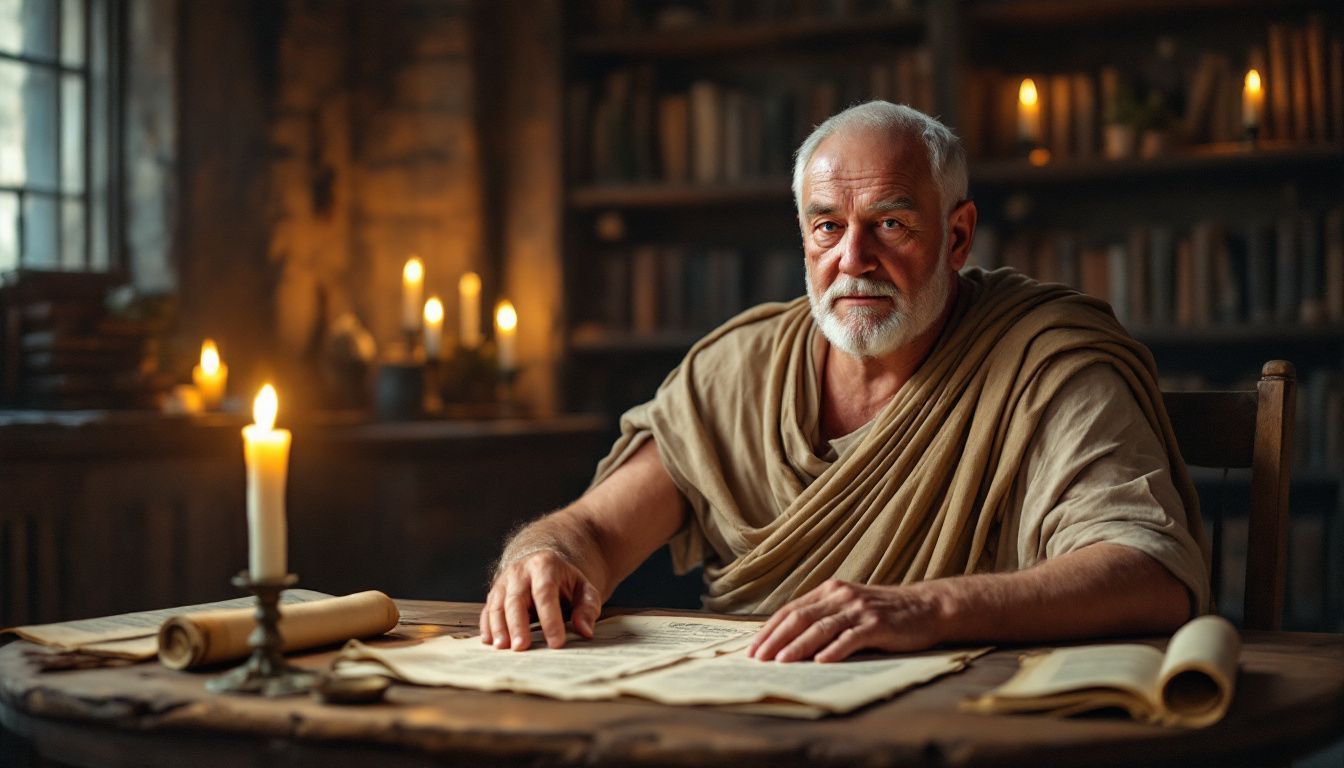
What Rome left shaped our world today in big ways, from politics to roads. Their ideas on government light the path for democracy today. Their trade and money systems still touch our economy. Rome’s army strategies teach modern soldiers a lot.
Even their laws guide how we see justice now. Let’s keep learning from Rome to make the future brighter.
FAQs
1. What role did the Roman Empire play in shaping modern politics and economics?
The Roman Empire, with its strong emperors like Gaius Flavius and Constantine XI, set a precedent for centralized control that influenced many future governments. Their system of loans also laid groundwork for today’s economic practices.
2. How has the Latin literature that Rome left impacts our world today?
Latin literature from authors such as Virgil and Horace is still widely studied today, contributing to Western literary traditions. It also shaped languages through loanwords into Albanian and other Romance languages.
3. Why is the fall of Rome significant in history?
The fall of Rome marked an end to one era but paved way for another – it led to the succession of the Eastern Empire under Eastern Emperors like Empress Irene and Andreas Palaiologos, which continued to influence European culture.
4. Can we see traces of Roman architecture in present-day buildings?
Absolutely! The use of Roman concrete revolutionized construction techniques worldwide while neoclassical architecture draws heavily on ancient Roman designs; even their innovative use in creating aqueducts remains influential.
5. How did Stoicism from Rome shape early Islamic philosophy?
Early Islamic philosophers like Ibn Sina (Avicenna) and Ibn Rushd (Averroes) were influenced by Stoic ideas via translations made during their time, leading them to develop concepts found in works such as “Incoherence Of The Philosophers.”
6. Did any other empire claim succession from Rome after its decline?
Yes, multiple entities claimed succession post-Rome’s decline including Holy Roman Emperors and Russian czars like Ivan III who saw themselves as successors or ‘third rome’, continuing some form of its legacy.


 Cart is empty
Cart is empty 






